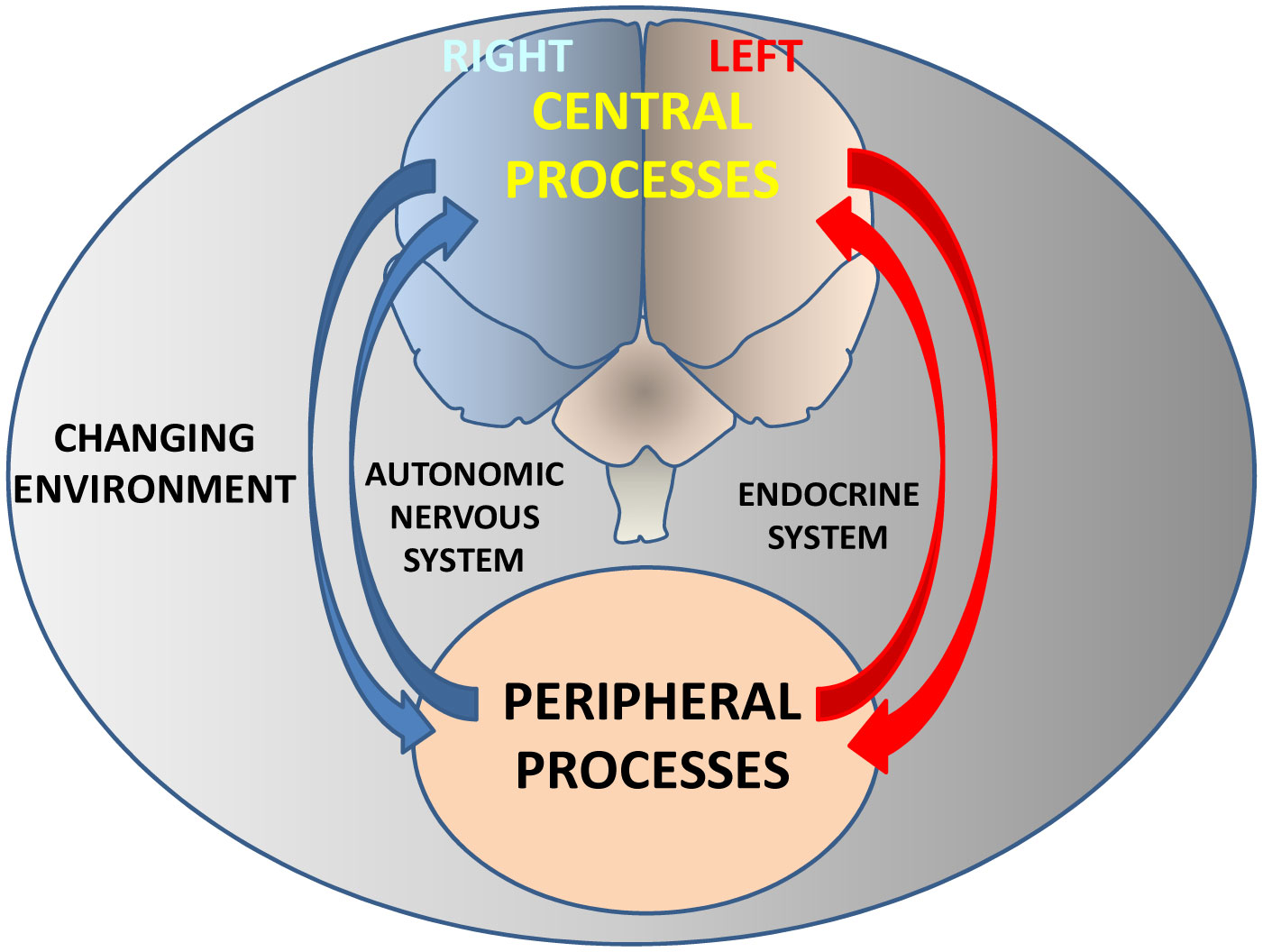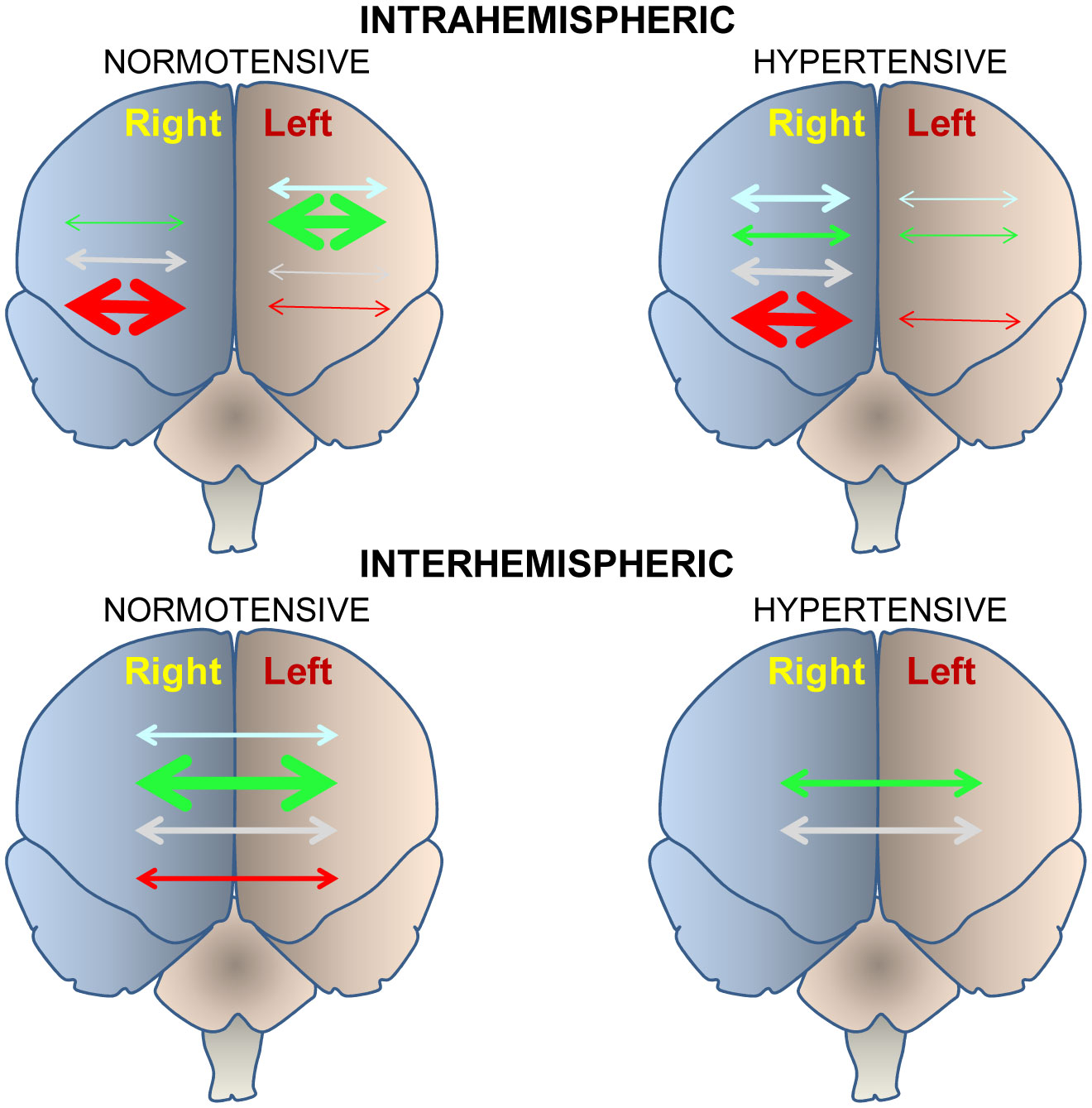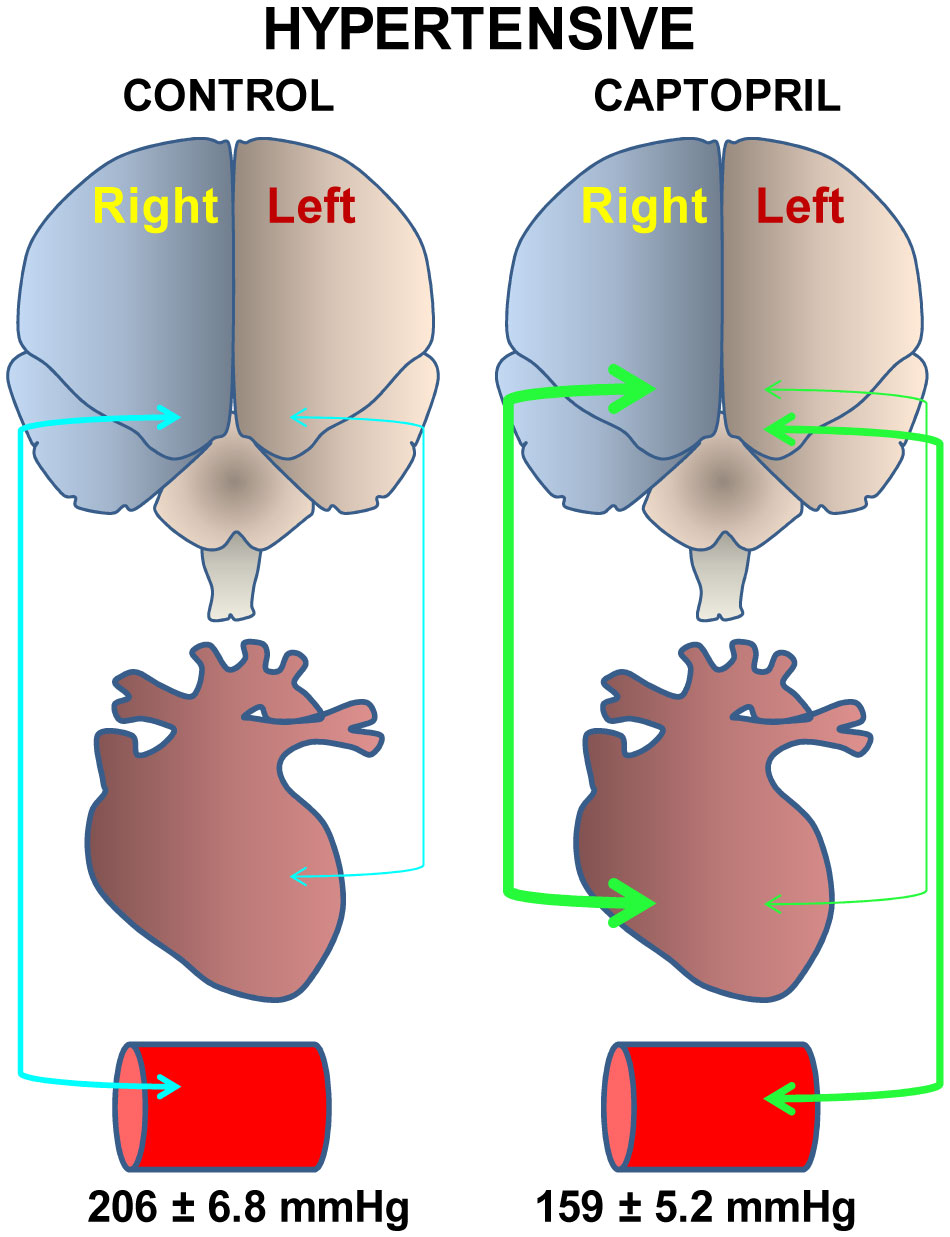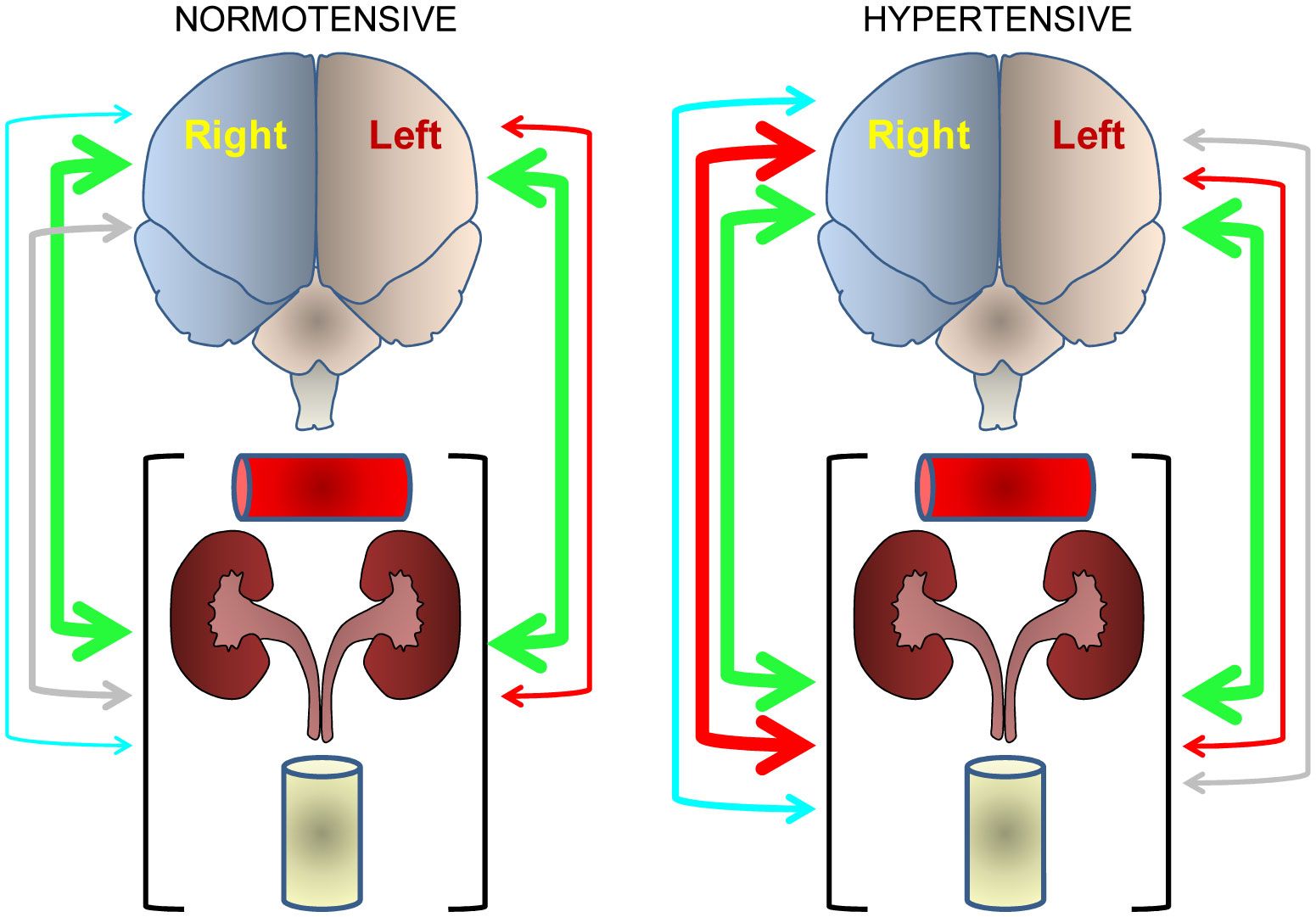Although at present depression is one of the most disabling disorders in our social environment, the understanding of its pathogenesis and the resources for its treatment are still unsatisfactory. The importance of brain asymmetry in the pathogenesis of disorders in brain function, including mood disorders such as depression, is a highly unexplored, sometimes underrated, and even ignored topic. It is important to note that the basal and pathological functional lateralization must have an underlying neurochemical substrate. It is also necessary to indicate that the brain asymmetry extends to a neurovisceral integration whose behavior may also be lateralized. One of the most studied axis from the functional point of view is the brain-heart connection, in whose operation there are observations that suggest an asymmetric behavior in basal conditions that is modified by central and peripheral changes, as well as by pharmacological treatments. There are evidences that connect cardiovascular function, neurochemical asymmetries, and depression. A deep understanding of the bilateral behavior of the brain following pathophysiological changes in blood pressure as well as pharmacologically induced, can provide us with therapeutic suggestions for the treatment of depression. In this article, we analyze remarkable results of some representative selected contributions, with which we discuss our proposal on the relationship between hypertension, depression and neurochemical asymmetry.
1.
Introduction
Fractional calculus (FC) is a subject that dates back to 1695 and is regarded to be as old as ordinary calculus. Ordinary calculus made it impossible to model nonlinear real-world phenomenon in nature, hence fractional calculus became popular among researchers. The fractional derivative is the derivative of arbitrary order in applied mathematics and mathematical analysis. In the nineteenth century, Riemann Liouville [1] implemented the fractional derivative when simulating real-world problems. Some of the Nobel contributions of mathematicians are listed here, Caputo [2], Kemple and Beyer [3], Abbasbandy [4], Jafari and Seifi [5, 6], Miller and Ross [7], Podlubny [8], Kilbas and Trujillo [9], Diethelm et al. [10], Hayat et al. [11], Debanth [12], Momani and Shawagfeh [13], etc. Fractional calculus has become one of the fascinating science and engineering research areas in recent years. Viscoelasticity and damping, diffusion and wave propagation, electromagnetism and heat transfer, biology, signal processing, robotics system classification, physics, mechanics, chemistry, and control theory are the most important scientific fields that use fractional calculus at the moment.
Researchers are interested in FC because of its wide applications in physics, engineering, and real-life sciences. Fractional differential equations accurately represent these physical facts. Fractional differential equations are significantly greater generalizations of integer-order differential equations. Fractional differential equations (FDEs) have generated much interest in recent years. As a result of their frequent appearance in diverse applications, such as quantum mechanics [14], chaotic dynamics [15], plasma physics [16, 17], theory of long-range interaction [18], mechanics of non-Hamiltonian systems [19], physical kinetics [20], anomalous diffusion and transport theory [21], mechanics of fractional media [22], astrophysics [23], and so on. FDEs have been the subject of numerous investigations. Many works have been dedicated to developing efficient methods for solving FDEs, but it is important to remember that finding an analytical or approximate solution is difficult, therefore, accurate methods for obtaining FDE solutions are still being researched. In the literature, there are several analytical and numerical approaches for solving FDEs. For example, the generalized differential transform method (GDTM) [24], adomian decomposition method (ADM) [25], homotopy analysis method (HAM) [26], variational iteration method (VIM) [27], homotopy perturbation method (HPM) [28], Elzaki transform decomposition method (ETDM) [29], iterative Laplace transform method (ILTM) [30], fractional wavelet method (FWM) [31, 32], residual power series method (RPSM) [33, 34].
In this paper, we used two powerful techniques with the aid of the Antagana-Baleanu fractional derivative operator and Laplace transform for solving time fractional NWSEs. The two well-known methods that we implement are LTDM and VITM. The suggested techniques give series form solutions having quick convergence towards the exact solutions. Four non-linear NWSEs case study issues are resolved using the given methodology. Newell and Whitehead [35] developed the non-linear NWSE. The diffusion term's influence interacts with the reaction term's nonlinear effect in the Newell-Whitehead-Segel equation model. The fractional NWSE is written in the following way:
where r is a positive integer and g,h are real numbers with k>0. The first term Dℑτμ(ξ,τ) on the left hand side in (1.1) shows the deviations of μ(ξ,τ) with time at a fixed location, while the right hand side first term D2ξμ(ξ,τ) shows the deviations with spatial variable ξ of μ(ξ,τ) at a specific time and the right hand side remaining terms gμ−hμr, is the source terms. μ(ξ,τ) is a function of the spatial variable ξ and the temporal variable τ in (1.1), with ξ∈R and τ≥0. The function μ(ξ,τ) might be considered the (nonlinear) temperature distribution in an infinitely thin and long rod or as the fluid flow velocity in an infinitely long pipe with a small diameter. Many researchers find the analytical solution of NWSEs [36, 37] due to their wide range of applications in mechanical and chemical engineering, ecology, biology, and bioengineering.
2.
Preleminaries
Some basic definitions related to fractional calculus are expressed here in this section.
Definition 2.1. The Caputo fractional-order derivative is given as
where n<ℑ≤n+1.
Definition 2.2. The Caputo fractional-order derivative via Laplace transformation LCDℑτ{g(τ)} is defined as
Definition 2.3. The Atangana-Baleanu derivative in Caputo manner is given as
where A(γ) is a normalization function such that A(0)=A(1)=1,g∈H1(a,b),b>a,ℑ ∈[0,1] and Eγ represent the Mittag-Leffler function.
Definition 2.4. The Atangana-Baleanu derivative in Riemann-Liouville manner is given as
Definition 2.5. The Laplace transform connected with the Atangana-Baleanu operator is define as
Definition 2.6. Consider 0<ℑ<1, and g is a function of ℑ, then the fractional-order integral operator of ℑ is given as
3.
The idea of LTDM
The solution by LTDM for partial differential equations having fractional-order is described in this section.
with some initial sources
where Dℑτ=∂ℑ∂τℑ is the fractional-order AB operator having order ℑ,ˉG1 is linear operator and N1 is non-linear and F(ξ,τ) indicates the source term.
Employing the Laplace transform to (3.1), and we acquire
By the virtue of Laplace differentiation property, we have
where
Now, applying inverse Laplace transform yields (3.3) into
where Θ(ξ,ω) demonstrates the terms occurring from source factor. LTDM determines the solution of the infinite sequence of μ(ξ,τ)
and decomposing the nonlinear operator N1 as
where Am are Adomian polynomials given as
Putting (3.5) and (3.7) into (3.4), gives
The following terms are described:
Thus all components for m≥1 are calculated as
4.
VITM formulation
The VITM solution for FPDEs is defined in this section.
with initial source
where Dℑτ=∂ℑ∂τℑ is stand for fractional-order AB operator, M is a linear operator and N is nonlinear term and P indicates the source term.
The Laplace transform is applied to Eq (4.1), we have
By the property of LT differentiation, we get
The iteration technique for (4.4) as
where ℑ(s) is Lagrange multiplier and
with the application of inverse Laplace transform, (4.5) series form solution is given by
5.
Convergence analysis
Here we discuss uniqueness and convergence analysis.
Theorem 5.1. The result of (3.1) is unique for LTDMABC, when
Proof. Let H=(C[J],||.||) with the norm ||ϕ(τ)||=maxτ∈J|ϕ(τ)| be the Banach space, for all continuous function on J. Let I:H→H is a non-linear mapping, where
Suppose that |L(μ)−L(μ∗)|<θ1|μ−μ∗| and |N(μ)−N(μ∗)|<θ2|μ−μ∗|, where μ:=μ(ξ,τ) and μ∗:=μ∗(ξ,τ) are two different function values and θ1,θ2 are Lipschitz constants.
where I is contraction as
From Banach fixed point theorem, the result of (3.1) is unique.
Theorem 5.2. The LTDMABC result of (3.1) is convergent.
Proof. Let μm=∑mr=0μr(ξ,τ). To show that μm is a Cauchy sequence in H. For n∈N, let
Let m=n+1, then
where
Similarly, we have
As 0<θ<1, we get 1−θm−n<1. Therefore, we have
Since ||μ1||<∞ and ||μm−μn||→0, when n→∞. As a result, μm is a Cauchy sequence in H, implying that the series μm is convergent.
6.
Applications
Four cases of nonlinear NWSEs are presented to demonstrate the suggested technique's capability and reliability.
Example 1. The NWSE has given in (1.1) for g=2,h=3,k=1 and r=2 becomes
with initial source μ(ξ,0)=Υ.
Applying Laplace transform to (6.1), we get
On taking Laplace inverse transform, we get
Assume that the solution, μ(ξ,τ) in the form of infinite series given by
where μ2=∑∞m=0Am are the so-called Adomian polynomials that represent the nonlinear terms, thus (6.3) having certain terms are rewritten as
According to (3.7), the decomposition of nonlinear terms by Adomian polynomials is defined as
Thus, on comparing both sides of (6.5)
For m=0, we have
For m=1, we have
The approximate series solution is expressed as
Therefore, we have
Particularly, putting ℑ=1, we get the exact solution
The analytical results by VITM:
The iteration formulas for (6.1), we have
where μ0(ξ,τ)=Υ.
For m=0,1,2,…, we have
Therefore, we obtain
Particularly, putting ℑ=1, we get the exact solution, see Figure 1 and Table 1.
Example 2. The NWSE has given in (1.1) for g=1,h=1,k=1 and r=2 becomes
with initial source
Applying Laplace transform to (6.13), we get
On taking Laplace inverse transform, we get
Assume that the solution, μ(ξ,τ) in the form of infinite series given by
where μ2=∑∞m=0Am are the so-called Adomian polynomials that represent the nonlinear terms, thus (6.15) having certain terms are rewritten as
Applying the proposed analytical approach and the nonlinear terms can be obtained with the aid of Adomian's polynomials stated in (3.7), we acquire
For m=0, we have
For m=1, we have
The approximate series solution is expressed as
Therefore, we obtain
Particularly, putting ℑ=1, we get the exact solution
The analytical results by VITM:
The iteration formulas for (6.13), we have
where
For m=0,1,2,…, we have
Therefore, we obtain
Particularly, putting ℑ=1, we get the exact solution, see Figures 2, 3 and Table 2.
Example 3. The NWSE has given in (1.1) for g=1,h=1,k=1 and r=4 becomes
with initial source
Applying Laplace transform to (6.24), we get
On taking Laplace inverse transform, we get
Assume that the solution, μ(ξ,τ) in the form of infinite series given by
where μ4=∑∞m=0Am are the so-called Adomian polynomials that represent the nonlinear terms, thus (6.26) having certain terms are rewritten as
According to (3.7), the decomposition of nonlinear terms by Adomian polynomials is defined as
Thus, on comparing both sides of (6.30)
For m=0, we have
For m=1, we have
The approximate series solution is expressed as
Therefore, we obtain
Particularly, putting ℑ=1, we get the exact solution
The analytical results by VITM:
The iteration formulas for (6.24), we have
where
For m=0,1,2,…, we have
Therefore, we obtain
Particularly, putting ℑ=1, we get the exact solution, see Figures 4, 5 and Table 3.
Example 4. The NWSE has given in (1.1) for g=3,h=4,k=1 and r=3 becomes
with initial source
Applying Laplace transform to (6.36), we get
On taking Laplace inverse transform, we get
Assume that the solution, μ(ξ,τ) in the form of infinite series given by
where μ3=∑∞m=0Am are the so-called Adomian polynomials that represent the nonlinear terms, thus (6.38) having certain terms are rewritten as
According to (3.7), the decomposition of nonlinear terms by Adomian polynomials is defined as,
Thus, on comparing both sides of (6.40)
For m=0, we have
For m=1, we have
The approximate series solution is expressed as
Therefore, we obtain
Particularly, putting ℑ=1, we get the exact solution
The analytical results by VITM:
The iteration formulas for (6.36), we have
where
For m=0,1,2,…, we have
Therefore, we obtain
Particularly, putting ℑ=1, we get the exact solution, see Figures 6, 7 and Table 4.
7.
Results and discussion
Figure 1, show the behavior of the exact and proposed methods solution at ℑ=1 in (AB fractional derivative) manner of Example 1. The comparison of the exact and analytical solution of Example 2 is shown Figure 2, whereas the graphical view for various fractional orders is demonstrated with the help of figures. In Figure 3, the two and three dimensional different fractional order graphs of Example 2. The figures show that our solution approaches the exact solution as the fractional order goes towards the integer-order. Figure 4, demonstrate the layout of the exact and analytical solution while Figure 5 shows the error comparison of the exact and analytical results of Example 3. The error confirms the efficiency of the suggested techniques. The graphical view of Example 4 for exact and our solution can be seen in Figure 6, however, Figure 7 shows the error comparison of both results. Furthermore, the behavior of the exact and proposed method solution with the aid of absolute error at different orders of ℑ is shown in Tables 1–4. Finally, it is clear from the figures and tables that the proposed methods have a sufficient degree of accuracy and quick convergence towards the exact solution.
8.
Conclusions
The LTDM and VITM were used for solving time fractional Newell-Whitehead-Segel equation. The solution we obtained is a series that quickly converges to exact solutions. Four cases are studied, which shows that the proposed methods solutions strongly agree with the exact solution. It is found that the suggested techniques are easy to implement and need a small number of calculations. This shows that LTDM and VITM are very efficient, effective, and powerful mathematical tools easily applied in finding approximate analytic solutions for a wide range of real-world problems arising in science and engineering.
Acknowledgements
This research received funding support from the National Science, Research and Innovation Fund (NSRF), Thailand.
Conflict of interest
The authors declare that they have no competing interests.
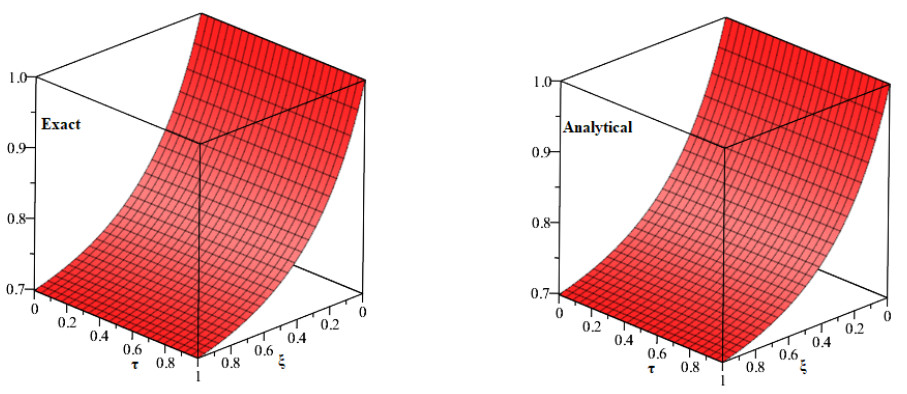









 DownLoad:
DownLoad:








